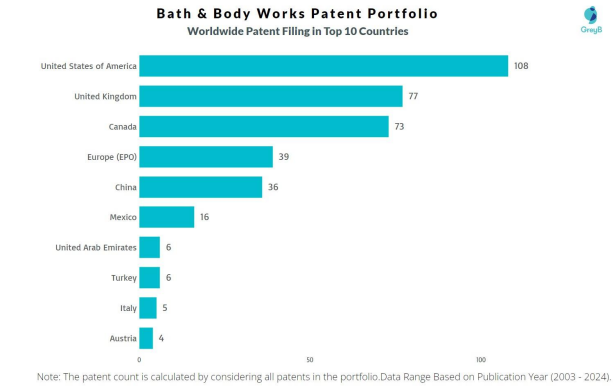Bath & Body Works surprised many with the successful launch of its laundry detergent line in 2023. However, a closer look at its patent filings could have prevented its competitors from being caught off guard. In actual, BBW’s interest in the laundry care space dates back to 2004. Understanding BBW’s patent portfolio reveals similar insights that can be used by the competitors for key findings, such as:
- Core Technologies and Patent Landscape: Identify BBW’s technical strength in anti-aging and other areas and the patents acting as hurdles for its competitors.
- Strategic Direction: Analyze BBW’s patent filing history to uncover potential areas of future innovation and product development.
- Competitive Advantage: Gain insights into BBW’s intellectual property strategy to know where to invest your research and development efforts in the white space.
Understanding BBW’s patent innovation can help other industry players proactively develop strategies to stay ahead in the ever-evolving personal care market. This knowledge will eventually be instrumental in avoiding patent infringements, identifying opportunities for differentiation, and ultimately gaining an edge in the personal care industry.
An Overlook of the Bath & Body Works’ Patent Portfolio
Bath & Body Works has a global presence, with over 400 patents filed worldwide belonging to 133 unique patent families. The US has the largest share of BBW’s patent filings, followed by the UK and Canada.

Additionally, significant filings in Europe and China suggest the importance of these regions for BBW’s plans to strengthen its presence there.
Moreover, the European skincare market is projected to grow at a compound annual growth rate (CAGR) of 4.3% from 2024 to 2030, driven by increasing consumer awareness about skincare benefits and rising demand for innovative products.
In China, the skincare market is experiencing rapid growth due to a burgeoning middle class, increased disposable income, and a strong preference for premium skincare products.
Additionally, government regulations in these regions often require more sustainable and consumer-friendly packaging, which aligns with BBW’s commitment to environmental responsibility and customer satisfaction.
To address these market needs, BBW has filed patents such as CN209252611U and CN205931651U, specifically designed to cater to the unique requirements of these regions.
Patent CN209252611U details a new packaging design focusing on improved functionality and user experience. This patent includes innovative features such as a tamper-evident seal, which enhances product safety, and an ergonomic design that ensures ease of use. The design also emphasizes the use of recyclable materials, addressing the stringent environmental regulations in Europe and China.
Patent CN205931651U involves a packaging solution that integrates advanced materials and manufacturing techniques to create a more durable and aesthetically pleasing package. This patent describes a multi-layered packaging structure that provides better protection for the product, ensuring it remains intact during transportation and storage. It also highlights a visually appealing design that attracts consumers, catering to the growing demand for premium skincare products in these markets.
By investing in these innovative packaging solutions, BBW aims to comply with local regulations, enhance its brand image, and meet the evolving preferences of consumers in Europe and China.
Key Technologies covered by Bath & Body Works Patents
As expected, BBW’s patents cover a range of core technologies directly related to its core products. Their patents encompass not only core technologies like skincare and fragrance but also a surprising emphasis on packaging and dispenser design.
This focus, coupled with the news of BBW’s commitment to sustainable packaging, hints at several exciting possibilities for the company’s future.
BBW’s ownership of over 100 design patents for containers, dispensers, and diffusers, combined with their recent sustainability push, suggests a strong focus on developing innovative and eco-friendly packaging solutions.
Many customers have praised the design and functionality of BBW products in their reviews. One review noted, “BBW’s diffusers are not only effective but also add a touch of elegance to my home decor.” This sentiment reflects that of many users who find BBW’s product designs both beautiful and functional.
BBW can strengthen brand loyalty and attract new customers who prioritize these attributes by emphasizing its commitment to innovation and sustainability in product design.
Additionally, BBW (Bath & Body Works) has recently made significant strides in expanding its product line to include laundry care products.
In late 2023, BBW launched its first-ever fabric care collection, which includes laundry detergents and fragrance boosters available in 14 different scents, such as Mahogany Teakwood, Eucalyptus Mint, and Champagne Toast. BBW’s patents related to laundry devices reflect its intent to protect its unique scent technologies and maintain a competitive edge by preventing other companies from using similar fragrance profiles. This strategic move secures its market position and capitalizes on the increasing preference for premium and personalized laundry care experiences.
Gain a comprehensive understanding of BBW’s innovation strategy and its impact on the personal care industry. Fill out the form below to learn more about the specific technologies covered by BBW’s patents.
5 Most Influential Innovations of Bath & Body Works
With 109 citations, Bath & Body Works’ most-cited patent (US6730137B2), though expired, offers a number of insights. The citations from players like Cargill and S.C. Johnson suggest that the described novel candle wax blend technology has now been used by almost all candle companies. This also means that companies are referencing and potentially building upon this innovation.
The high citation count shows the technical importance of the addressed challenge. Notably, companies outside the candle industry, such as Elevance Renewable Sciences, have cited this patent, indicating that BBW’s candle wax technology is inspiring advancements in sustainable ingredients across various sectors.
Below is the list of 5 most cited patents of Bath & Body Works:
| Publication number | Citation Count |
|---|---|
| US6730137B2 | 109 |
| US20110027124A1 | 94 |
| US20040033463A1 | 93 |
| US6923639B2 | 77 |
| USD578395S1 | 70 |
US20040033463A1 – Hand Sanitizer Composition
With 93 citations, this patent for a hand sanitizer composition highlights BBW’s role in developing effective and pleasant-smelling hand sanitizers. This innovation was particularly influential during the COVID-19 pandemic, which saw a surge in demand for hand sanitizers. BBW’s formulation includes moisturizing agents to prevent skin dryness, addressing a common consumer complaint.
Companies facing rejections due to BBW’s patents
Analyzing which companies and technologies are most impacted by BBW’s patents helps identify areas where innovation might be more challenging due to existing patent barriers.
Eventually, understanding the specific details of BBW’s patents will help other players develop innovative workarounds or alternative technologies that don’t infringe on BBW’s intellectual property rights.
The USPTO’s examiners referred 17 Bath & Body Works patents in 88 rejections (35 USC § 102 or 35 USC § 103 types).
The top companies facing rejection due to the Bath & Body Works patent portfolio are Mary Kay Inc., Deerpath Capital, and Cargill Inc.
Key Bath & Body Works’ Patents Used to Reject Competitors’ Applications
| Patent Number | Count of Rejected Applications |
| US8435541B2 | 10 |
| US8496948B2 | 4 |
| US6730137B2 | 4 |
| US8301019B2 | 3 |
| US7277626B2 | 3 |
What can you expect from Bath and Body Works in the coming years?
Eco-Friendly Candles
Bath & Body Works’ patent landscape reveals its focus on continuous innovation in the scented candle market. Their 2021-expired patent (US6730137B2), which was the most cited one, focused on a novel wax blend for enhanced burning and fragrance. This technology has already expired. However, what truly caught our attention is the adjusted expiration date on another BBW patent (US20160348030A1), extending protection until 2035.
This patent explores the use of non-ionic emulsifiers in candles, likely improving performance in several key areas:
- Enhanced Burning Characteristics: Non-ionic emulsifiers can create a more consistent and stable burn, reducing issues like tunneling and uneven melting. This leads to a longer-lasting candle, a significant factor for consumers looking for value and efficiency in their purchases.
- Improved Fragrance Delivery: These emulsifiers can help distribute fragrance oils more evenly throughout the wax, ensuring a consistent scent throw from the beginning to the end of the candle’s life. This meets the consumer demand for long-lasting and impactful fragrance experiences.
- Reduced Soot and Smoke: The innovative use of non-ionic emulsifiers can result in cleaner burning candles with minimal soot and smoke, addressing environmental and health concerns. Consumers are increasingly aware of indoor air quality, making this a crucial selling point.
We expect BBW to leverage its protected technology to develop candles that perform exceptionally well and cater to evolving consumer preferences. The projected market growth, driven by a desire for organic, natural, and eco-friendly candles (as highlighted in a recent report forecasting a market size of USD 10.61 billion by 2032), suggests BBW might integrate these elements into their future formulations.
The future of the candle market is those with superior burning characteristics, long-lasting fragrance, and minimal environmental impact, all achieved through innovative use of non-ionic emulsifiers.
Anti-Aging Line
Another active patent that hints towards Bath & Body Works’ future plans is US8435541B2. This patent details a formulation that includes a unique combination of active ingredients such as peptides, antioxidants, and moisturizing agents, which work synergistically to reduce the appearance of fine lines and wrinkles, improve skin elasticity, and enhance overall skin texture.
While BBW has not yet commercialized this technology, the booming anti-aging skincare market (projected to reach $93 billion by 2027) suggests potential.
Considering the patent’s focus on “tropical application,” a logical next step for BBW could be anti-aging hand creams. These products perfectly align with BBW’s core strength in hand care and tap into the growing consumer demand for age-defying skincare solutions.
Whether BBW capitalizes on this opportunity remains to be seen, but this active patent certainly hints at a possible anti-aging hand cream future for the brand.
Conclusion
This analysis of Bath & Body Works’ patent portfolio has given a peek into their innovation strengths, potential future directions, and the competitive landscape they’ve shaped.
But BBW is just one player in the personal care domain. Players like Estee Lauder, Alticor, and Coty have much to reveal in their patent data.
Gain a similar level of foresight for other players in the personal care domain or perhaps a specific competitor of yours. Leverage the power of patent analysis to unlock the innovation secrets to propel your business forward.
Author: Annie Sharma, Marketing.










